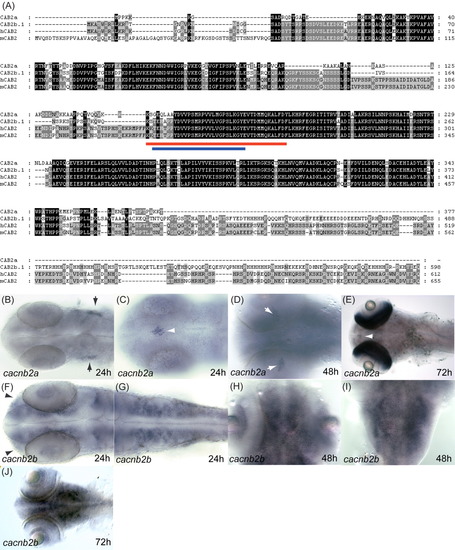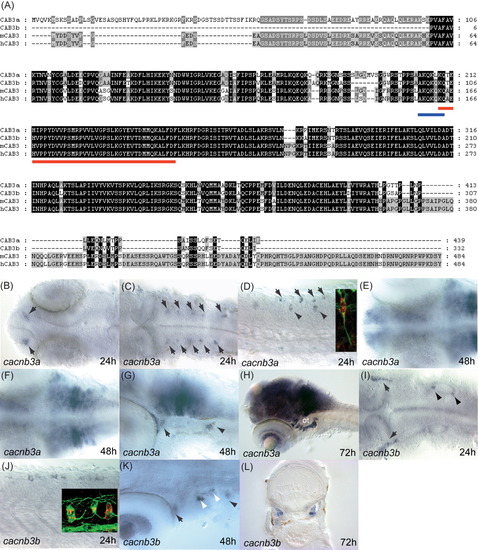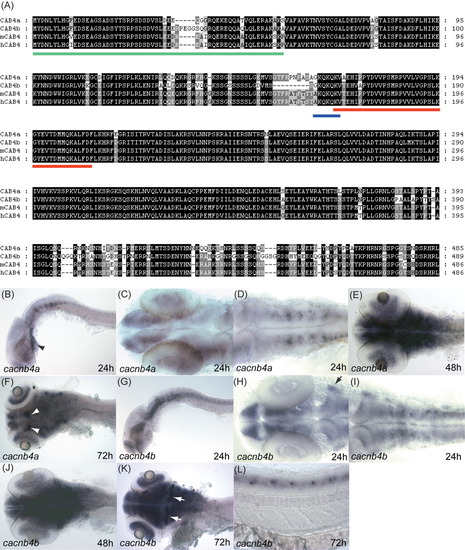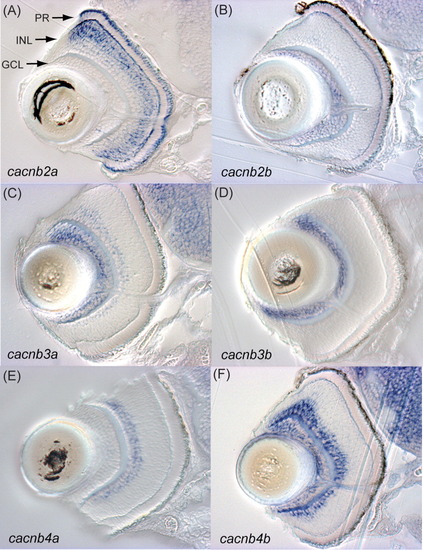- Title
-
Identification and expression of voltage-gated calcium channel beta subunits in Zebrafish
- Authors
- Zhou, W., Horstick, E.J., Hirata, H., and Kuwada, J.Y.
- Source
- Full text @ Dev. Dyn.
|
Zebrafish cacnb2a and cacnb2b genes. A: Alignment of proteins encoded by zebrafish and mammalian CACNB2 genes shows that they are highly homologous to each other. The red bar underlines the β interaction domain (BID). The blue bar underlines the deletion in the cacnb2b.2 variant. B: Ventral view of the head region showing that cacnb2a is expressed in the trigeminal ganglion (arrows) at 24 hours post fertilization (hpf). C: View of the dorsal surface of the brain showing expression of cacnb2a in the epiphysis at 24 hpf. D: View of ventral surface of the brain showing strong expression of cacnb2a along the optic stalks (white arrows) and weaker expression in the brain at 48 hpf. E: Dorsal view of head region of a 72 hpf embryo showing expression of cacnb2a in the epiphysis (white arrowhead) and in the retina. F: Dorsal view showing that cacnb2b is expressed in the brain and olfactory placodes (arrowheads) at 24 hpf. G: Dorsal view showing that cacnb2b is expressed in the hindbrain and spinal cord at 24 hpf. H: Dorsal view showing that cacnb2b is strongly expressed in the brain and the retina at 48 hpf. I: Dorsal view showing that cacnb2b is expressed in the hindbrain at 48 hpf. J: Dorsal view of 72 hpf embyro showing strong cacnb2b expression in the brain. Anterior is left in all the panels except (H-I). EXPRESSION / LABELING:
|
|
Zebrafish cacnb3a and cacnb3b genes. A: Alignment of proteins encoded by zebrafish and mammalian CACNB3 genes shows that they are highly homologous to each other. The red bar underlines the β interaction domain (BID). The blue bar underlines the AKQKQKQ/S/V motif that is conserved in β1, β3, and β4. B: Dorsal view of the head showing that cacnb3a is expressed in two groups of cells (arrows) in the forebrain adjacent to the olfactory placodes at 24 hpf. C: Dorsal view of the hindbrain showing the expression of cacnb3a in discrete bilateral groups of cells (arrows) that may represent reticulospinal neurons at 24 hpf. D: Lateral view of the spinal cord showing cacnb3a is expressed in cells in the dorsal cord likely to be Rohon-Beard neurons (arrows) and commissural neurons (arrowheads) at 24 hpf. Inset from of an embryo labeled with the cacnb3a riboprobe (red) and anti-acetylated-α-tubulin (green) showing a cacnb3a-expressing commissural neuron extending a ventrally-directed axon. E: Dorsal perspective of the head showing cacnb3a is expressed diffusely in the brain at 48 hpf. F: Dorsal view of the hindbrain showing that at 48 hpf cacnb3a is strongly expressed by discrete groups of cells in rhombomeres 4-6 based upon the location of the otocyst. G: Lateral view of the hindbrain showing expression of cacnb3a in the trigeminal ganglion (arrow) and posterior lateral line ganglion (arrowhead) as well as the cells in rhombomeres at 48 hpf. H: Lateral view of 72 hpf embryo showing strong expression of cacnb3a in the brain, the retina and the cells ventral to the otocyst (ot). I: Dorsal view of the hindbrain at 24 hpf showing cacnb3b expression in the trigeminal ganglion (arrows) and in two groups of cells likely to be sensory neurons in the otic vesicle (arrowheads). J: Lateral view of trunk at 24 hpf showing cacnb3b expression in dorsal cells likely to be Rohon-Beard neurons in the spinal cord. Inset from an embryo labeled with the riboprobe for cacnb3b (red) and anti-acetylated-α-tubulin (green) showing that the dorsal cells express cacnb3b and extend longitudinal axons in the dorsal spinal cord consistent with them being Rohon-Beard neurons. K: Dorsal view at 48 hpf showing cacnb3b expression in the retina, trigeminal ganglion (arrow), otic cells (white arrowhead) and posterior lateral line ganglion (black arrowhead). L: Transverse section of 96 hpf embryo showing cacnb3 expression within the otocysts. Anterior is left in (B-K). EXPRESSION / LABELING:
|
|
Zebrafish cacnb4a and cacnb4b genes. A: Alignment of protein sequences encoded by zebrafish and mammalian CACNB4 genes shows that they are highly homologous to each other. The red bar underlines the β interaction domain (BID). The blue bar underlines the AKQKQKQ/S/V motif that is conserved in β1, β3 and β4. The green bar underlines the β4-specific D1 domain. B: Lateral view showing cacnb4a expression in the brain and the cardiac tube (arrow) at 24 hpf. C: Dorsal view showing expression of cacnb4a in the forebrain, retina, and midbrain at 24 hpf. D: Dorsal view showing cacnb4a is expressed in the hindbrain and spinal cord at 24 hpf. E: Dorsal view showing cacnb4 is expressed strongly in the brain at 48 hpf. F: Dorsal view of 72 hpf embryos showing cacnb4a expression in the brain. The white arrowheads indicate the two groups of cells in the dorsal midbrain with strong expression of cacnb4a. G: Lateral view showing cacnb4b is expressed in the brain and spinal cord at a higher level than cacnb4a at 24hpf. Note cacnb4b is not detected in the cardiac tube. H: Dorsal view of the hindbrain showing cacnb4b is strongly expressed in the forebrain, midbrain, and trigeminal ganglia (arrow) at 24 hpf. I: Dorsal view showing cacnb4b is expressed in hindbrain and spinal cord at 24 hpf. J: Dorsal view showing strong expression of cancb4b in the brain at 48 hpf. K: Dorsal view of 72 hpf embryo showing expression of cacnb4b persists in the brain. The white arrows indicate stronger expression of cacnb4b in the cerebellum compared with the rest of the brain. L: Lateral view at 72 hpf showing expression of cacnb4b by periodically located cells in the spinal cord. Anterior is left in all the panels. EXPRESSION / LABELING:
|
|
Expression of cacnb genes in zebrafish retina at 96 hpf. Transverse sections indicate that zebrafish cacnb genes are expressed in distinct regions in the retina at 96 hpf. A: cacnb2a is expressed in the outermost inner nuclear layer (INL) and by photoreceptors (PR). B: cacnb2b is expressed in the ganglion cell layer (GCL). C: cacnb3a is expressed in GCL and the innermost INL. D: cacnb3b is expressed exclusively in the GCL. E: cacnb4a is expressed only in the innermost INL. F: cacnb4b is expressed in GCL and the innermost INL. EXPRESSION / LABELING:
|




